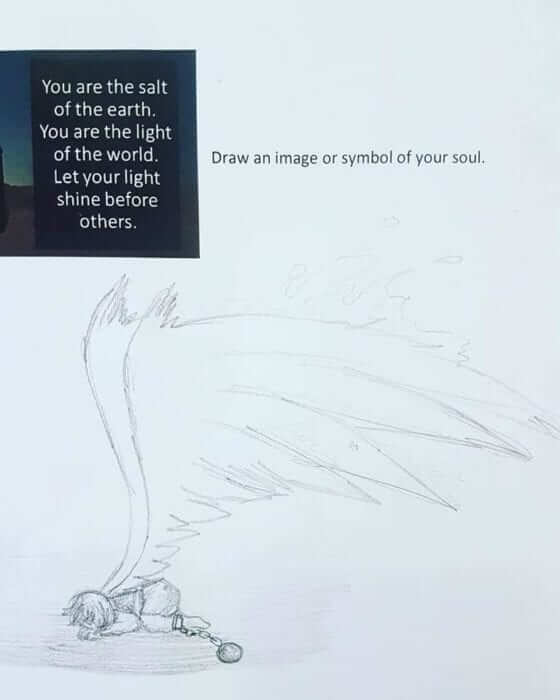How do you define and describe the soul and spirituality for a broad range of people?
The human soul is the life force within each of us, animated by God[1], our spirituality is how we cultivate and express that energy in either healthy or unhealthy ways[2] and the ultimate fulfillment of a healthy spirituality is to love and be loved[3].
Engaging language about the soul can form the basis of a new set of personal narratives for retreat participants that offer new possibilities[4]. In my retreat work with children, teenagers and adults, the above broad definition breaks open what it means to cultivate a healthy spirituality much more readily and invites all participants to reflect genuinely on their lives.
The above empowering definition of the human soul and fulfilment of human life is grounded in Genesis. The main lesson from both Genesis stories is that every person is alive by the love of God and we find fulfilment through living harmoniously with God, each other and the earth[6]. In Genesis 2:7 we learn that we come alive by the very life of God as we read, “and he breathed life into the earth creature’s nostrils to come alive”[7]. Rolheiser profers that our soul is something we are, an unquenchable desire, the very ‘life-pulse’ that makes us alive[8]. Groome explains that we are alive with God’s own life, our breath is his breath of love for us, and our soul is the animating principle of this[9].
This soul, this life-force within us, compels us to restlessness, not peace, according to Rolheiser[10]. It seems that our soul is constantly experiencing loneliness, an insatiable hunger for a deeper connection. It always stirs us forward, outward or inward, striving to quench an unquenchable fire. Made in the image of God (Genesis 1:27) we are wired for connection and for transcending ourselves in love[11].
Everyone has a soul and spirituality. Spirituality is how we cultivate and express that fire within us. Our spirituality can be healthy, integrative and life-giving or unhealthy, dismantling and destructive. A healthy soul and life-giving spirituality, according to Rolheiser, will keep us energised, vibrant and hope-filled as well as keep us ‘fixed together’, integrating our sense of how we belong and why we are here. Our soul is our aliveness and the way we stay unified throughout our whole person. The energetic and integrative aspects of our soul can be suffocated by too much order and dissipated by too much chaos, leading to loss of life [12].
The acknowledgment and empowerment of the human soul and development of a healthy spirituality can be a profound source of confidence, resilience and inspiration in a society that often denies human dignity and defines a human by what he/she can consume[13]. If a person identifies themselves as having a soul, a spirituality and a foreseeable path to human fulfilment based on love, then she/he has access to personal narratives that open up many possibilities regarding inner strength, resilience, peace, hope, joy, confidence, healthy relationships and courage. Creating a new narrative in which the person is the main character shapes meaning and changes the way we interpret the world around us and our agency within it. What we emphasise or neglect in our personal life narratives has real effects on us and how we behave in the world[14].
In Evangelii Gaudium, Pope Francis explains that the use of images can be a particularly impactful and relatable way of conveying the wonderful truth of the Gospel and awaken a desire within people to move towards love [15]. I have already found that using the above language and images has engaged 3 broad groups of teenagers.

A thirteen-year-old girl sketched these images at a retreat day recently. Her first drawing responded to the question, “What does your soul look like today?
“I have all this fire within me, and even my wings are on fire because I have all this love and happiness inside me, but I can’t work out how to express it to my family.”
Her second sketch responded to the question, ‘How would soul look if it was 100% confident?”

“If my soul was 100% confident I would know how to spread love and happiness easily and freely with my family and everyone. My fire wouldn’t be trapped.”
The following retreat activities invited her and her classmates to make commitments towards creating a healthy spirituality that finds expression in loving and receiving love from others, ourselves and God. It was clear by the enthusiasm and thoughtfulness showed by the girls that this language engaged them meaningfully and empowered them with new confidence. This particular teenage girl thanked me after retreat for helping her to see new ways she can be confident and more loving in her world. To me, that is the evidence of effective, empowering language around the soul, spirituality and human fulfilment through love.
The soul is our very life-force, given by God, our spirituality is the way we express and cultivate that energy in either life-giving or destructive ways and our fulfillment is found in loving and being loved. This broader language is an exciting tool for me to use in retreats as a way of inviting participants to re-write the way they see themselves and their ways of being in this world. When people are empowered to cultivate healthy spirituality they increase their toolset for building inner strength, confidence, hope, love, peace and joy and so engaging language around this topic is crucial for improving their wellbeing.
Copyright 2019 Donna Power
[1] Groome, T. H. ‘Who do we think we are? Living as graceful people’ in Groome, Thomas H., What Makes Us Catholic? Eight Gifts for Life. 1st ed., (San Francisco: Harper SanFrancisco, 2002) Page 50
[2] Rolheiser, R. The Holy Longing: The Search for a Christian Spirituality. (New York: Doubleday, 1999). Page 6
[3] Francis (2013). Evangelii Gaudium (#39), see www.va.com.au , (accessed March 22 2019)
[4] Freeman J, Epston D, & Lobovits D. Playful Approaches to Serious Problems: Narrative Therapy with Children and their Families. New York: W. W. Norton & Company, 1997. Chapter 3, Page 47
[5] Rolheiser, R. The Holy Longing: The Search for a Christian Spirituality. (New York: Doubleday, 1999). Page 6
[6] Jacobs-Vandegeer, Dr Christiaan. Lecture notes during THCT504: Catholic Ethos and Care of the Person in Grad Cert in Leadership and Catholic Culture (Melbourne: ACU, 2019) Monday March 18.
[7] Groome, ‘Who do we think we are?’ p 50
[8] Rolheiser, The Holy Longing: p 12
[9] Groome, ‘Who do we think we are?’ p 50
[10] Rolheiser, The Holy Longing’ p 3
[11] Francis (2013). Evangelii Gaudium (#39), see www.va.com.au , (accessed March 22 2019)
[12] Rolheiser, The Holy Longing P 11-14
[13] Francis, Evangelii Gaudium (#55)
[14] Freeman, Narrative Therapy with Children p 47
[15] Francis, Evangelii Gaudium (#157)

